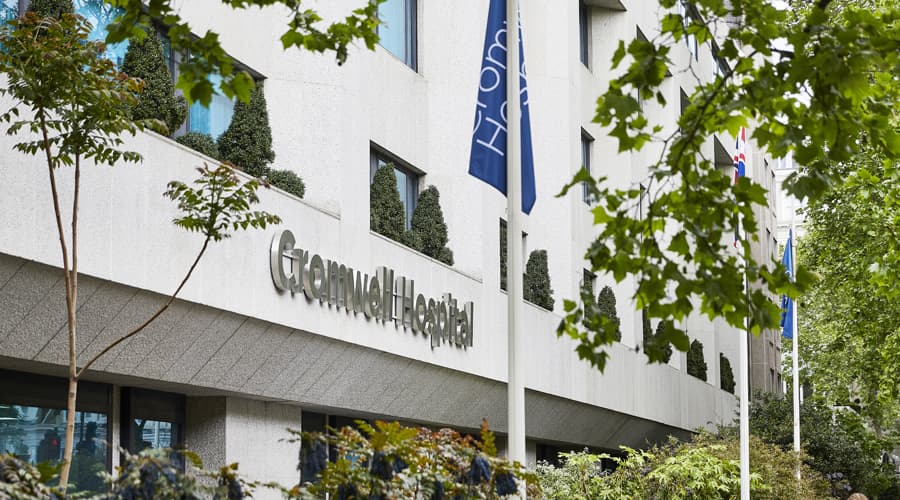Sleeve gastrectomy
A sleeve gastrectomy is a type of weight loss surgery that involves removing 60 to 70% of the stomach, leaving behind a long, thin tube.
Reviewed by Mr Ahmed Ahmed, Consultant GI and Bariatric Surgeon
At a glance
Who's it for?
Patients with a BMI above 35 or patients with a BMI above 30 (above 27 in people of Asian origin) that also have type 2 diabetes.
What's involved?
A sleeve gastrectomy involves reducing the stomach size and converting the rest into a tube, around the size and shape of a banana.
What's recovery like?
A one-night stay in hospital, with a one week of recovery time.
What is a sleeve gastrectomy?
Sleeve gastrectomy, also known as gastric sleeve surgery, is a type of weight loss (bariatric) surgery to reduce the size of the stomach.
The surgeon will do this by removing part of your stomach. The remaining part of the stomach is made into a long, thin tube, similar to the size and shape of a banana. The operation is performed using keyhole surgery and normally takes 30-45 minutes.
The new stomach is about a third of its original size, which restricts the amount of food you can eat and means you feel fuller sooner, and for longer.
You are likely to be recommended a sleeve gastrectomy if you have tried and failed to lose weight and meet the following requirements:
- Your BMI is above 35
- You have BMI of 30 and above (or >27 if Asian) and have type 2 diabetes
You must also be willing to commit to long-term dietary and lifestyle changes, which will be monitored at follow-up appointments.
A sleeve gastrectomy is done under general anaesthetic and takes around 30-45 minutes.
A sleeve gastrectomy is carried out laparoscopically (also known as keyhole surgery). In keyhole surgery, the surgeon makes several small cuts in your abdomen, rather than one large cut. They will carry out the operation using small surgical instruments and video images from a telescopic camera to guide them.
Your surgeon will create a narrow ‘sleeve’ by stapling your stomach vertically and removing the larger, curved part of the stomach. Your surgeon will then close the cuts in your abdomen using dissolvable stitches or small metal clips and place a dressing over the cuts.
You’ll normally be able to go home one to two days after the operation. You can resume walking as soon as possible and return to work and normal activities within a week of surgery. You can travel one week after surgery.
Long term – along with adopting a healthier lifestyle – you will need regular blood tests once a year to ensure you are getting enough nutrients. You may also need to take some nutritional supplements, such as a generic multivitamin and mineral preparation.
After the procedure, you may experience mild abdominal pain and tenderness. When you start eating again, you may feel sick or even vomit – this will go away once your stomach adjusts to its new size.
A sleeve gastrectomy can have rare complications, including:
- Wound infection
- Gastric leakage
- Bleeding
A sleeve gastrectomy is a surgical procedure that requires the patient to commit to changing their lifestyle and dietary habits.
Before deciding whether to have surgery, patients should consider the following:
- Dietary and lifestyle changes: For your surgery to be successful, you will need to be committed to following a healthy, balanced diet and exercising regularly.
- Follow-up appointments: You will need to be able to attend scheduled follow-up appointments
There are several different types of bariatric treatment, both surgical and non-surgical. If you would prefer a non-surgical approach, we offer treatments including weight loss injections, gastric balloons and endoscopic sleeve gastroplasty (ESG).
Why choose us for sleeve gastrectomy?
World-class bariatric surgeons
Our consultant bariatric surgeons are experts in their field, having trained at top UK teaching hospitals.
Tailored dietary advice
Our dietitians work with patients to create tailored meal plans that support their health and weight loss goals.
Behavioural support
Weight loss programmes are delivered with the support of specialist psychiatrists and psychologists.
Specialist anaesthetist
Weight loss surgeries are supported by our specially trained bariatric anaesthetist.
Paying for your treatment
We welcome both self-paying and insured patients.
Self-pay patients
We offer several ways for patients to self-pay, including pay-as-you-go and self-pay packages.
Insured patients
At Cromwell Hospital, we accept private health insurance from most major providers, including AXA, Aviva, Bupa, and Vitality.
Our locations

Book an appointment today
Our telephone lines are open 8am to 8pm Monday to Friday and 8am to 2pm Saturdays.
Alternatively, fill out our appointment request form and we'll be in touch shortly.
Please note - regrettably we are unable to answer specific medical questions or offer medical advice via email or telephone.
